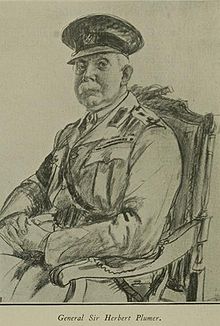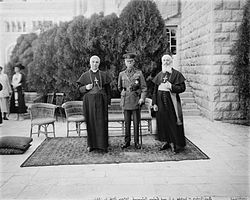Herbert Plumer, 1st Viscount Plumer - Picture
More about World War 1

|
|
Herbert Plumer, 1st Viscount Plumer
The Viscount Plumer
Place of birth: Torquay, England
Resting place: Westminster Abbey
Allegiance: United Kingdom
Service/branch: British Army
Years of service: 1876 - 1919
Rank: Field Marshal
Battles/wars: Mahdist War
Second Matabele War
Second Boer War
World War I
Awards: Knight Grand Cross of the Order of the Bath
Knight Grand Cross of the Order of St Michael and St George
Knight Grand Cross of the Royal Victorian Order
Knight Grand Cross of the Order of the British Empire
Grand Cordon, Order of the Rising Sun
Other work: High Commissioner of Palestine
Field Marshal Herbert Charles Onslow Plumer, 1st Viscount Plumer, GCB, GCMG, GCVO, GBE (13 March 1857 - 16 July 1932) was a British colonial official and soldier born in Torquay who commanded the British Second Army in World War I and later served as High Commissioner of the British Mandate for Palestine.
Military career
Educated at Eton. Plumer was commissioned into the York and Lancaster Regiment in 1876.
From 1879 to 1886, an unusually long period, he was Adjutant of his battalion, and in that capacity accompanied it to the Soudan in 1884 in the expedition under Sir Gerald Graham. Captain Plumer was present at the battles of El Teb and Tamai, and was mentioned in Despatches. In 1887 he passed through the Staff College, and from 1890 to 1893 was Deputy-Assistant Adjutant-General in Jersey. In 1896 he served in the operations in South Africa under Sir Frederick Carrington, when he organized and commanded a corps of Mounted Rifles, subsequently obtaining another mention in Despatches and a brevet Lieutenant-Colonelcy. Colonel Plumer's experiences in this arduous campaign are described in a very interesting manner in his book "With an Irregular Corps in Matabeleland." After service in South Africa he was appointed Commander of the 4th Brigade within I Army Corps in 1902 before moving on to be General Officer Commanding 10th Division within IV Army Corps in 1903. In 1904 he became Quartermaster-General to the Forces and in 1906 he became GOC 5th Division within Irish Command. Then in 1911 he was appointed General Officer Commanding-in-Chief for Northern Command.
He served in the Second Army in Flanders during World War I, during which he won an overwhelming victory over the German Army at the Battle of Messines in 1917, started with what was described as the loudest explosion in human history, created by the simultaneous explosion of 19 mines by the Royal Engineer tunnelling companies.
Plumer is generally regarded as one of the finest army commanders serving in France during World War I. Unlike the majority of generals on the Western Front he was from an infantry, as opposed to a cavalry background and deprecated the insistence on the value of the "breakthrough" and the effectiveness of cavalry to exploit the opening and reach the open country beyond the front line.
As a career Infantry officer it could be argued that he understood somewhat better what could reasonably be expected of his troops bearing in mind the terrain, the weather and morale. Plumer, a meticulous planner, would often express the plans of his superiors as being too ambitious and more often than not, as seen at the Third Battle of Ypres, he would be proved to be right.

Picture - Wartime sketch of General Plumer
Plumer was very popular with the men gaining the affectionate nickname "old Plum" and "Daddy Plumer". He was a cliché of a General to look at; with a receding chin and a white moustache, his appearance suggested on the photographs of the day everything that he was not.
Following the unexpected death of Sir James Grierson on his arrival in France in 1914, Plumer was considered for command of one of two BEF Corps alongside Haig. This position eventually went to Horace Smith-Dorrien. Later in the war, Plumer was sought by Lloyd George for the position of Chief of the Imperial General Staff as a replacement for William Robertson. He declined the position and leaving no private papers and never having expressed a recorded opinion of the conduct of the war, the lengthy debate over the Generalship in World War I largely passed him by.

Picture - Lord Plumer with archbishop of Naples & Latin Patriarch 11 Aug 1926
Post World War I
He became Commander of the British Army of the Rhine in 1918, Governor of Malta in 1919 and then High Commissioner of the British Mandate for Palestine in 1925 and resisted Arab pressure to reverse commitments made by the British in the Balfour Declaration. His three-year term as High Commissioner is generally noted as the calmest period during the British Mandate. He was replaced by Sir John Chancellor in 1928.
He was buried in Westminster Abbey.
Honours
Knight Grand Cross of the Order of the Bath
Knight Grand Cross of the Order of St Michael and St George
Knight Grand Cross of the Royal Victorian Order
Knight Grand Cross of the Order of the British Empire
Grand Cordon, Order of the Rising Sun, 1921.
Further reading
Harington, General Sir Charles Plumer of Messines Murray, 1935
Powell, Geoffrey Plumer: The Soldier's General: A Biography of Field-Marshal Viscount Plumer of Messines Pen and Sword Books Ltd (19 Jul 1990) ISBN 0-85052-605-1 / Leo Cooper Ltd (Jan 2004) ISBN 1-84415-039-9
Sykes, Frank W. With Plumer in Matabeleland: an account of the operations of the Matabeleland Relief Force during the rebellion of 1896 Constable & Co, London, 1897. Reprints: Rhodesiana Reprint Library, Vol 21, Books of Rhodesia, Bulawayo, 1972 and Negro Universities Press, 1969 ISBN 0-8371-1640-6.
Yockelson, Mitchell A. (30 May 2008). Borrowed Soldiers: Americans under British Command, 1918. Foreword by John S. D. Eisenhower. University of Oklahoma Press. ISBN 978-0806139197.
More aircraft.
Source: WikiPedia